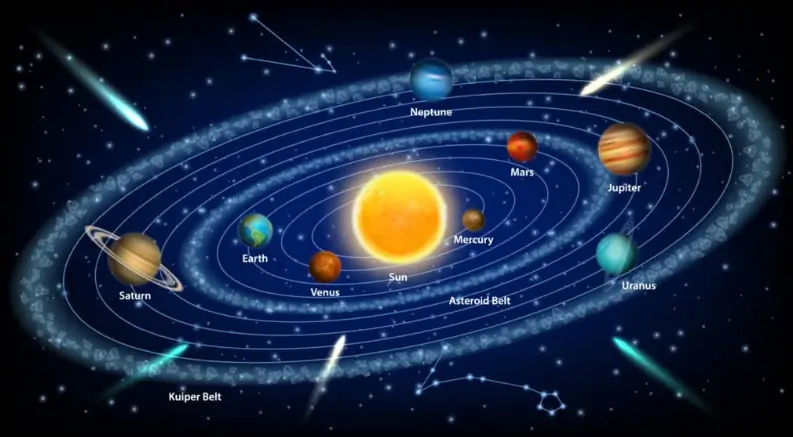The solar system, a vast expanse of space dominated by the Sun and its orbiting celestial bodies, has intrigued humanity for millennia. With advancements in technology, our understanding of this cosmic neighbourhood has deepened, revealing a diverse array of planets, moons, asteroids, comets, and other fascinating objects. In this article, we embark on a journey through our solar system, exploring its composition, dynamics, and remarkable features.

The Sun: Our Radiant Star
At the heart of the solar system lies the Sun, a dazzling ball of hot, ionised gases primarily composed of hydrogen and helium. With a diameter of about 1.4 million kilometres (870,000 miles), the Sun dwarfs all other objects in the solar system. It serves as the primary source of light, heat, and energy, sustaining life on Earth and influencing the dynamics of the entire solar system through its gravitational pull.
The Inner Planets: Rocky Worlds
Moving outward from the Sun, the inner solar system is home to four terrestrial planets: Mercury, Venus, Earth, and Mars. These rocky worlds are characterized by solid surfaces, relatively high densities, and thin or nonexistent atmospheres.
- Mercury: The closest planet to the Sun, Mercury is a scorched world with extreme temperature variations, ranging from scorching hot days to freezing cold nights. Its surface is heavily cratered, evidence of intense bombardment from space debris.
- Venus: Veiled in thick clouds of sulphuric acid, Venus is often referred to as Earth’s “sister planet” due to its similar size and composition. However, its atmosphere is a hostile environment, with temperatures soaring to over 450°C (840°F) and crushing atmospheric pressure.
- Earth: Our home planet, Earth, is unique in the solar system for its abundant water, diverse ecosystems, and hospitable climate. It boasts a dynamic geology, with tectonic activity, volcanic eruptions, and erosion shaping its surface over billions of years.
- Mars: Known as the “Red Planet” due to its rusty hue, Mars features a barren landscape marked by towering volcanoes, deep valleys, and polar ice caps. Recent discoveries suggest that Mars once had rivers, lakes, and possibly even oceans, raising tantalising questions about the potential for past life.
The Asteroid Belt: Relics of the Early Solar System
Between the orbits of Mars and Jupiter lies the asteroid belt, a region populated by millions of rocky objects varying in size from tiny fragments to large bodies several hundred kilometres across. These asteroids are believed to be remnants from the early solar system, leftover building blocks that never coalesced into a planet due to Jupiter’s gravitational influence.
Comets: Celestial wanderers, comets follow highly elliptical orbits around the sun. When they draw near to Earth, they become visible to the naked eye. Among the well-known comets are Halley’s Comet and Hale-Bopp. Halley’s Comet graces our skies roughly every 76 years, last appearing in 1986 and anticipated to return in 2062.
Meteors: When small space debris enters Earth’s atmosphere, it hurtles in at immense speeds, generating friction that often incinerates it before reaching the ground. These fiery streaks are known as meteors or shooting stars. Occasionally, larger fragments survive the fiery descent and impact the Earth’s surface, becoming meteorites. These can inflict significant damage, posing threats to life and property.
Artificial Satellites: Crafted by human ingenuity, artificial satellites serve a myriad of purposes. From remote sensing to telecommunications and defence, they play vital roles in modern life. Meteorologists rely on satellite data for weather forecasts, while communication satellites facilitate mobile phones and television transmissions. The Global Positioning System (GPS) owes its functionality to these orbiting marvels.
The Outer Planets: Gas Giants and Ice Giants
Beyond the asteroid belt, the outer solar system is dominated by the gas giants Jupiter and Saturn, along with the ice giants Uranus and Neptune.
- Jupiter: The largest planet in the solar system, Jupiter is a behemoth composed mostly of hydrogen and helium. Its turbulent atmosphere is adorned with colourful bands, swirling storms, and the iconic Great Red Spot, a massive storm larger than Earth.
- Saturn: Famous for its spectacular ring system, Saturn is a gas giant similar in composition to Jupiter. Its rings, made up of countless icy particles ranging in size from dust grains to boulders, provide a breathtaking sight through telescopes.
- Uranus: Unlike Jupiter and Saturn, Uranus is an ice giant with a predominantly hydrogen and helium atmosphere surrounding a rocky core. Its unusual tilt causes it to appear to roll on its side as it orbits the Sun, leading to extreme seasons that last for decades.
- Neptune: The outermost planet in the solar system, Neptune is similar in size and composition to Uranus. It boasts powerful winds, dark storm systems, and a moon named Triton, which exhibits active geysers spewing nitrogen gas into space.
Dwarf Planets, Moons, and Beyond
In addition to the major planets, the solar system is home to a variety of dwarf planets, moons, and other small bodies that orbit the Sun or larger planets. Notable examples include Pluto, once considered the ninth planet until its reclassification as a dwarf planet in 2006, and its moons Charon, Nix, and Hydra. Other dwarf planets include Eris, Haumea, and Makemake, each with its own unique characteristics and features.
Conclusion: A Window into the Cosmos
Our solar system is a testament to the immense complexity and beauty of the universe. From the fiery inferno of the Sun to the icy realms of the outer planets, each celestial body offers valuable insights into the formation and evolution of planetary systems. As we continue to explore and study our cosmic neighbourhood, we gain a deeper understanding of our place in the universe and the possibilities that lie beyond.
In our quest for knowledge and exploration, the solar system serves as a gateway to the cosmos, inspiring wonder and curiosity in the hearts and minds of humanity for generations to come.




